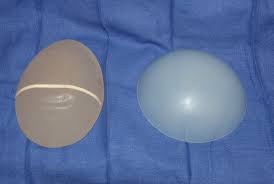
The level of surgical difficulty of buttock implant augmentation was most recently illustrated by a story published in the New York News and video posted online. In this video, a women is shown revealing her buttock and demonstrating how she could rotate and flip her buttock implants with simple manual manipulation. Rotating the implant from its round outer convex side to its flat inner side created quite a buttock deformity, clearly not the result she was hoping to get.
While the buttock implants were not infected or had any wound healing complications, how does such a result happen. In short, this case demonstrates numerous points about the use of buttock implants and how to use them properly…or in this case improperly.
First, the highest rate of long-term success of any synthetic implant placed in the body is when they are placed into deeper tissues. Having a thicker and more vascularized soft tissue is always a friend of an implant. The very fact that she can move or flip her implants around indicates that they are in a subcutaneous pocket. While this is the easiest place to put buttock implants, it is far from the best. The best location for buttock implants is in an intramuscular pocket. It is harder surgery to do and the recovery is longer, but the results are much better with lower risks of such problems as infection, fluid collections and implant displacement. Having breast implants in a subcutaneous pocket is one thing, but when you have to sit on your implants takes on a different level of stress on them.
Secondly, the size of her buttock implants is enormous. Big buttock implants, larger than 350cc or 400cc, can not be placed in an intramuscular pocket no matter how large the patient is. While patients often ask for large implants or the largest available, they do not really understand what they are asking for. It can be very impressive how much difference a 300cc or 350cc implant can make in an intramuscular location. While large buttock implants are manufactured (up to650cc), and they obviously are made based on surgeon demand, I see little reason for them. A very large buttock implant not only stretches out the skin but causes fat tissue atrophy, potentially leaving the implant merely covered with skin. When this happens the implant can have great mobility, rotating around the pocket like a ball bearing.
Thirdly, and an unknown factor in this case, is the recovery process. It is critically important to let the tissues around the implant heal so a stable pocket is obtained. This is as true above the muscle as it is inside the gluteal muscle. The recovery from buttock implants should not be confused with that of breast implants. It is easily two to three times longer, particularly as it relates to significant physical activity. One should be prepared to have a recovery process that includes a month of no exercise and limited sitting. Patinets should not undergo the procedure unless one has a real commitment to the healing process. Getting a good capsule around the implants is a key to preventing the exact problem illustrated in this video.
Implants are the most reliable method of buttock augmentation but requires an experienced surgeon and a committed patient to get an uncomplicated and satisfying result.
Dr. Barry Eppley
Indianapolis, Indiana


